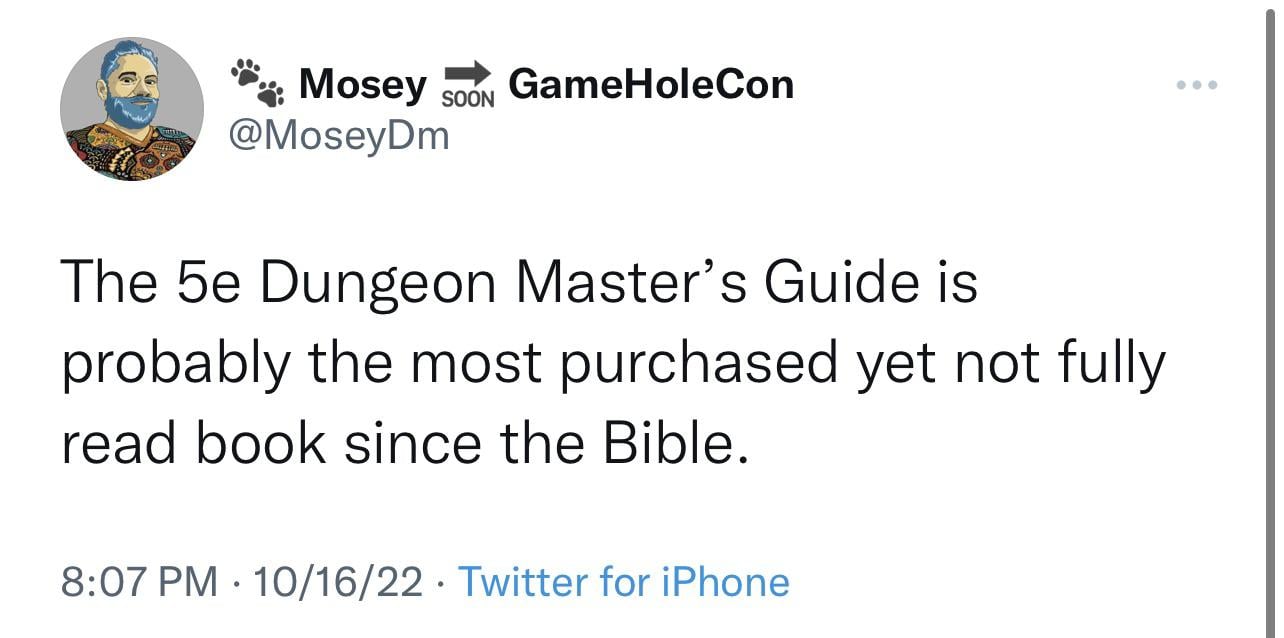this post was submitted on 07 Mar 2024
661 points (99.0% liked)
RPGMemes
12394 readers
1363 users here now
Humor, jokes, memes about TTRPGs
founded 2 years ago
MODERATORS
you are viewing a single comment's thread
view the rest of the comments
view the rest of the comments

When you say 2.5, do you mean 3.5? 3.5 was an actual edition, still widely played (what I started on, even though 5e existed at the time). I've heard some people refer to late 2nd edition (I think particularly after the combat and tactics optional material) as 2.5e, but only in a very informal sense as an acknowledgment of how much one of those later supplements changed the game. Second edition is a hard sell for a modern audience, as you have to think about THAC0, to-hit tables, weird saves vs specific things, etc. It's what Baldur's Gate 1 and 2 run on.
3.5 is much more intuitive than second edition in terms of its core mechanics, but had a huge amount of supplementary material released for it. It's still a detailed and crunchy system, and usually if you hear people talking about crazy character builds where they figured out how to become omnipotent at level 5 or used metamagic to wipe out a 200 mile radius with a level 4 spell, they're probably talking about 3.5. It's also what pathfinder is based on - you can basically play pathfinder 1 and d&d 3.5 if you've learned to play one of them, they're not identical but they're closer than any actual editions.
5 is much less crunchy than 3.5 or 2, and easier to learn, while still having good systems in place. I've heard it referred to as "everyone's second favorite system", on the basis that it's so well-rounded (of course, in practice it's plenty of people's favorite or only system). I think it leans a bit more on dungeon master (referee) interpretation/judgment, which might make it less viable for a video game, but clearly Baldur's Gate 3 works just fine using it. I've been curious since BG3 was announced how they went about fully mechanising parts of it, but haven't yet gotten around to checking it out.
If you're new to tabletop RPGs and just looking for inspiration and only looking at one system, 5 is probably your best bet - and if you run into part of it and wonder how this could translate to a computer context, you can always check what BG3 did for reference.
Actually, now that I've said that though, 4e is worth mentioning too. It's usually not in the discussion for most tabletop group discussions, because of how video gamey it is, but a) that works in your favor here, and b) it does introduce some good stealable ideas, in addition to the video-gamey combat overhaul. Notably skill challenges and minion-type enemies. Another comment already gave a good discussion of 4e though, I just wanted to acknowledge that it's a decent contender in spite of what I said about 5e being your best bet. The only reason it's an afterthought is that it's sort of the black sheep of the d&d family for tabletop purposes.
Edit: you know what, just since I ended up addressing every mainline numbered edition except 1, I'll give a quick note on that. It's basically 2 but worse. The change from 1st to 2nd was a much smaller change than all the other ones, so people basically treat them as the same thing. But 2nd edition is the finished one. It's a bit more complicated than that and there's a few other versions from around that time, plus modern attempts to replicate the feel of that time, but I feel like for your purposes nothing before 3.5 is likely to be worth thinking too hard about.
I'm open to follow-up questions if any part of this rambling comment needs elaboration or clarification. I intended to just clarify the 2.5 vs 3.5 thing but it kind of got away from me.
Okay so, 2, 3, 4 or 5, but not 1.
😁
Seriously though, thank you! I'll check out the 5 (apparently there are easy to find pdf around) and maybe the 3 and 4 if that doesnt tick.